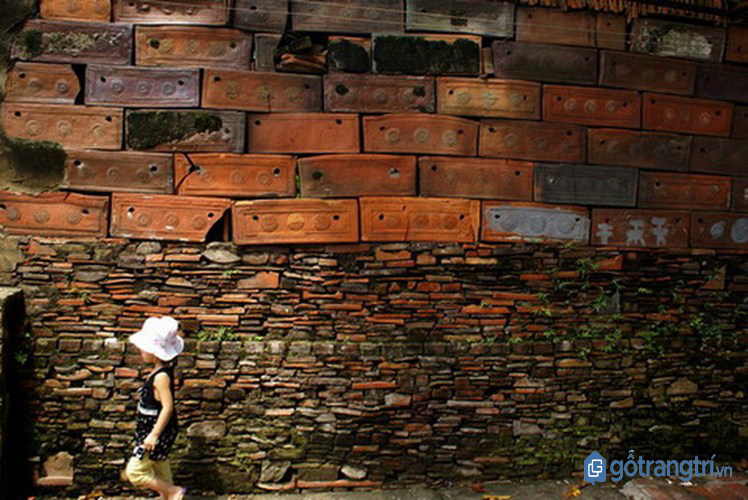1. A brief history of Tho Ha pottery village (Bac Giang)
Tho Ha pottery craft dates back to the 12th century and is one of the three oldest ceramic centers of the Vietnamese people, next to Phu Lang and Bat Trang.
According to the village genealogy and archaeological samples found, Tho Ha is one of the cradles of ceramics. Tho Ha was a busy pottery trading port of Kinh Bac region.
The flourishing of the pottery profession has helped people build a complex of majestic architecture of communal houses, pagodas, literature, and village gates.
In the village, there is a story that the ancestor of Tho Ha pottery village is Dr. Dao Tri Tien. At the end of the Ly dynasty, three men Dao Tri Tien, Hua Vinh Cao and Luu Phong Tu worked together as mandarins in the court and were sent to the Northern Song Dynasty (960-1127).
After completing the mission, on the way back home to Shaozhou, Guangdong province encountered a storm, had to rest.
There is a famous pottery kiln here, his father visited and learned the technique of making pottery.
Returning to the country, Dao Tri Tien taught the profession of making crimson ceramics to Tho Ha, Hua Vinh Cao taught the profession of making white ceramic products to Bat Trang, Luu Phong Tu passed on the profession of making dark yellow ceramics to Phu Lang.
Previously, the ceremony of offering incense to the pottery ancestors (respecting all three of them) was annually held by potters in Tho Ha at home.
In the 40s of the last century, Tho Ha pottery making was very developed.
In the mid-60s of the last century, the population in the village developed, the pottery kilns consumed a lot of land and caused pollution, so the state established Da Vang Pottery Factory on the hilly area of Lat village, 3 km from Tho Ha. To the North, all of Tho Ha’s pottery-making people became factory workers and received state salaries.
- Discover the 600-year-old Dong Xam silver carving village in Thai Binh
- The quintessence of carpentry and handicrafts in Chang Son craft village – Hanoi
- Discover the art of wood carving in Son Dong craft village
In the early 80s, the economy of the subsidy period was extremely difficult, and the villagers switched to a new profession of making rice noodles and making wine from cassava.
During this time cooking rice wine and selling alcohol was still prohibited. Many workers have left the ceramic factory to return to work.
By 1988, plastic had become common, and products such as large and heavy clay pots and jars were difficult to sell, so Da Vang Pottery Factory was dissolved, putting an end to the nearly 900-year-old pottery profession of Tho village. River.
In 2005, Mr. Trinh Dac Tan, a person born into a family of 10 generations of pottery, opened a pottery kiln to restore traditional pottery, producing all kinds of crockery jars, crock pots, cottages, flowerpots, cup accumulation. The restoration faced many difficulties and needed the attention and help of the government and the people.
2. Explore Tho Ha pottery village (Bac Giang)
Because of its long history of formation and development, Tho Ha pottery village still retains many ancient relics imbued with traditional Vietnamese cultural values.
In which, Tho Ha village communal house was built in 1692, this is a cultural work ranked as a national historical relic. The dragon and phoenix pattern hidden in the clouds harmonizes with people and plants, flowers, and animals, and also records the imprint of the talented hand of the engraver.
Going into the village, the most interesting is the small alleys. A red color of worn-out old bricks, showing the spirit of the footsteps of time, the alley is attractive, the wall is lined with a glossy dark brown earthenware.
Visitors to this place often have a special impression with the beautiful hun alleys with an ancient, nostalgic but rustic, quiet look.
In the past, Tho Ha pottery did not use glaze, that miraculous plastic earth was fired until the glaze itself melted, clinging to the surface of the pottery a smooth, velvety brown color.
The village only made household items, the famous jars, cottages, and poodles for a while. The surface of the ceramic ware is dark purple, hard, and rattles like cold steel.
The pieces of ancient pottery left on the walls are still intact, so the soul of the pottery seems to remain forever.
Stepping into Tho Ha pottery village, you have entered a picture frame of national history, with the most features of the ancient architecture and art of pottery making.
Above is some useful information about Tho Ha pottery village – Bac Giang. Do not forget to follow the next articles of gotrangtri.vn to update the best articles on art architecture as well as beautiful house design!
Source: Collected internet.





